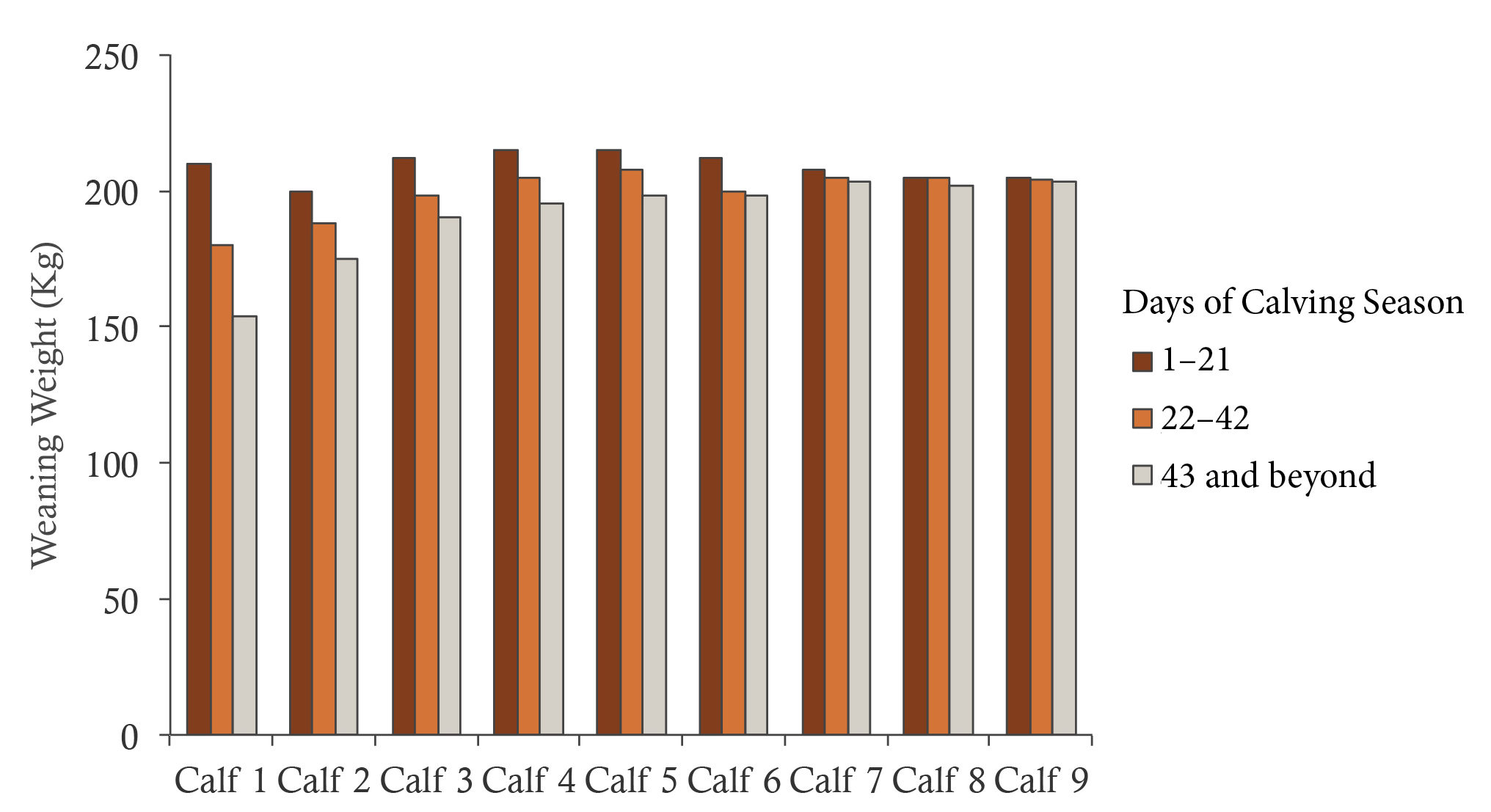Establishing a controlled breeding and calving season that works best with your operation is vital to the profitability and sustainability of your cattle business. A part-time farmer’s operations may require a different calving season than one that works best for a full-time farmer, but both can obtain substantial benefit from establishing a controlled breeding season.
Calving seasons are usually classified into three categories:
- Winter (January–February): Although it means calving in the coldest time of the year, the winter season sets your calves up to wean on summer pasture, leading to higher weaning weights. The cow herd must be watched closely for calving and calf health problems.
- Spring (March–April): A spring calving cow herd will have increased nutritional needs during the winter leading up to calving, and good winter grazing or access to economical feed-supplement is needed.
- Fall (September–October): Fall calving allows the use of summer pasture to keep the cow herd in good condition prior to calving. Calf health, however, will have to be watched closely due to the extreme swing in temperatures from early September to late October. Your first calf may be born when the temperature is 100℉, but it may drop to 35℉ by the time your last calf arrives.
Developing your production cycle, forage and feed, and marketing plans will enable you to determine which of the above calving seasons will work best for your operation. These plans can assist in identifying the advantages to a controlled breeding season.
Production Cycle Plan
The production cycle plan is a set of guidelines that outline best management practices which must be performed annually. This plan answers the questions (1) what needs to be done, (2) when does it need to be done, and (3) which cows does it need to be done to. Although some actions may be contingent upon other decisions or outcomes. For example, if drought occurs and grazing is limited, then the contingency may be to early wean the calves. A controlled breeding season allows you to have one production cycle plan in place. Without the controlled breeding season, every cow’s production cycle is different, and therefore multiple production cycle plans are required.
Forage and Feed Plan
The forage and feed plan may be the most important tool you can develop for your operation. Nutrition is the single most important driver of reproduction on a beef cattle operation. Establishing a forage feed plan allows producers to schedule supplement, mineral, fertilizer, and herbicide purchases depending on need. More importantly, producers use growth curves of available forages to determine when forage availability works best with the production cycle.1 Cattle producers are really forage farmers that use cattle to harvest their crops and produce a high-quality product. A controlled breeding season allows you to target your high-quality grazing for certain times within the production cycle. For example, producers would want to offer the highest quality grazing and supplement to the 2-year-old cow that is lactating, still growing, and selected for rebreeding. In the continuous breeding system, cattle are unable to be sorted for increased nutrition, as calving occurs throughout the year.
Marketing Plan
The marketing plan should establish guidelines for how and when your cattle would be marketed. Questions to consider would consist of
- Will you market or will you retain ownership?
- Will you market purebred genetics?
- Will you market weaned calves?
- Will you market weaned / backgrounded calves?
A producer may choose to retain ownership on his calves unless he is limited on grazing or supplement prices exceed potential profit. It is important to have a written plan with marketing contingencies to aid in the decision-making process. A controlled breeding season will help you meet the goals of your marketing plan. Figure 1 shows the increased profit potential of calves born in the first twenty-one days of the calving season, due to increased weaning weight. Cattle that calve in the first twenty-one days of the breeding season are also more likely to breed back the next year, and their daughters will be more likely to become pregnant replacement females.

Figure 1. Influence of calving date in first calving season on average weaning weight of calves. Adapted from Mousel et al.2
Developing your production cycle, forage and feed, and marketing plans will provide a blueprint that is specific to each individual operation and having a controlled breeding and calving season is just part of that process. Transitioning from a continuous breeding season to a defined breeding season can present challenges. To be successful in the transition from continuous breeding to a controlled 90-day breeding season, several steps must be taken:
- Determine when your breeding season will take place.
- Make sure you have adequate facilities to house bulls when they are not with cows.
- Develop and implement a plan for how the transition will be carried out.
Producers have two options when it comes to making the transition, both have advantages and disadvantages.
Option 1: Use a period of three to four years to gradually decrease the amount of time in your breeding season. This option allows producers to maintain a calf crop every year and cull open cows that do not fall within the parameters of that year’s breeding season (table 1). The time investment and management to make this transition can be a challenge and a long-term commitment.
Table 1. Continuous to controlled breeding season transition.
|
Year |
Breeding Season |
|
1 |
Continuous Breeding |
| 2 |
Continuous to 180-day breeding |
|
3 |
180 – 138-day breeding |
| 4 |
138 – 90-day breeding |
Option 2: Use one year and transition all of your cattle. If you select an April breeding season, bulls should be removed on April 1 of year one. The last calves would be born in January, and bulls should be turned out April 1 of year two for your 90-day breeding season. Option 2 will cause the loss of one year’s calf crop due to the extended period of time that bulls are removed, however, it does make the transition much quicker.
In summary, transitioning to a controlled breeding season from a continuous breeding season will take discipline and adequate management. It is important to maintain accurate records and develop a plan for where you want your operation to be in five years. Determining the time for the breeding season is critical. Extensive planning will ensure the proper timing for individual operations. It becomes very difficult to alter the breeding season once the transition has been implemented. Establishing a controlled breeding season will increase operation efficiency, decrease nutritional needs, decrease labor needs, and when combined with other best management practices, increase profit (table 2).
Table 2. Characteristics of a controlled vs. continuous breeding/calving season.
| Management Practice | Controlled Breeding/Calving Season | Continuous Breeding/Calving Season |
| Nutrition | Supplement or provide grazing to meet the needs of all cows during specific times of the production cycle | Trying to meet the needs of cows in different stages of the production cycle. |
| Forage Use Efficiency | Strategic grazing of high-quality forages at pre-determined stages in the production cycle to improve reproductive success and calf health. This also includes key management strategies to offset the detrimental effects of K-31 Tall Fescue.3 | Management cannot dictate which cattle are pregnant/open and therefore does not graze accordingly. |
| Marketing | Calves born in the first twenty-one days will on average weigh 100 lbs. more at weaning. Group marketing will give a premium of $4-$10/cwt. | Calves are born and marketed at different times or different weights and therefore do not receive any premium. |
| Selection and Culling | Weaning is a good time to cull based on pregnancy status, feet, udder, disposition, and performance. | No expectations or guidelines are established and therefore cattle cannot be compared. |
| Heifer Development | Heifers born early in the calving season are more likely to breed earlier in the breeding season and maintain that advantage for almost nine years of production. | Difficult to design a true heifer development program with maturity levels varying by 365 days. |
References Cited
- Ball DM, Hoveland CS, Lacefield GD. Southern forages. Third Edition. Norcross (GA): Potash and Phosphate Institute and the Foundation for Agronomic Research, 2002.
- Mousel EM, Cushman RA, Perry GA, Kill LK. 2012. Effect of heifer calving date on longevity and lifetime productivity. Proceedings of the Applied Reproductive Strategies in Beef Cattle: Sioux Falls, SD.
- Burns M. Timing of exposure to toxic tall fescue: Effects on beef cattle reproduction [dissertation]. Clemson: Clemson University; 2012.

